 |
Preserving
the Sounds
of a Lifetime |
 |
THE SCRATCH DJ STRAIGHT TONEARM
DESIGN AND APPLICATION DATA
With the re-introduction of the straight,
pivoted tonearm for Scratch DJ applications, I have decided to dredge up the
design data that describes it. It is not new. The data presented in this
document is from the Radiotron designers handbook circa 1955. The Audio
Engineering bible.
The Straight tonearm has historic
underpinnings as the first tonearm design style. It wasn't until the 1940's
that serious math was applied to the phonograph tonearm. From that math evolved
the more common overhung, offset tonearm we see most common today. The "S"
shape, "J" shape or the straight, long arm with the angled head shell. All these arms angle the cartridge at approximately 18° and overhang the spindle by about 0.5" and are meant for hi fidelity playback.
The purpose of this article is to show why the Scratch
DJ straight arm cannot be used for serious listening and may even do harm to
your records if certain stylus shapes are used with it.
You
can tell the two different straight arm types apart very easily by seeing where the
stylus lands relative to the spindle. Just bring the arm over to the spindle.
In a high fidelity arm, the needle will "overhang" the spindle by 1/2" or so. In a
scratch DJ arm, the needle will "underhang" or come up short about 3/8"
behind the spindle. Also the high fidelity arm will have an angled headshell. The Scratch DJ arm will not.
The high fidelity tonearm has a
maximum tracking error of around 2 degrees which is good. This results in a
maximum distortion from tracking error of around 0.75%, also good.
The
Scratch DJ straight arm has a tracking error that varies from -6 degrees to +
17 degrees which is terrible. This results in a maximum distortion due
to mistracking of 6.7% which is terrible.
Take note that the
error varies from a negative angle to a positive one as it moves across the
record. This means that there is only one point where the error is 0. Changing
the cartridge angle, as some Mfg's recommend, will reduce the error at one
end... only to increase it at the other!
For best
results, keep everything straight.
The Following 2 drawings depict the stylus with proper groove alignment and the maximum mis-alignment that occurs when using the scratch DJ straight arm.
It is important to understand that the stylus suspension allows the stylus to swing side to side and up and down; BUT NOT FORWARD! The stylus is presumed to be rigid to forward movement. Note in the 18° error drawing that the groove is clearly trying to move the stylus forward. Since the stylus cannot do this, it will chatter and move up against the groove. This is where the groove wear is at it's greatest.
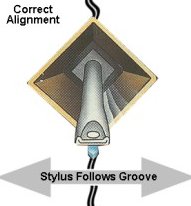
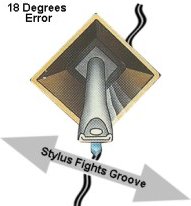
The following images and text are
taken verbatim from the Radiotron Designers Handbook. Just so you don't think
that I am making all this up!
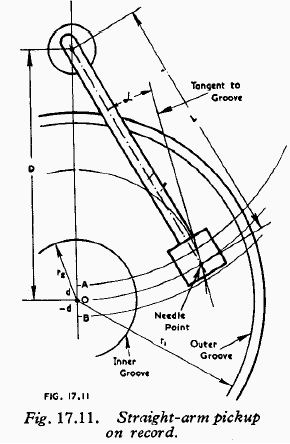

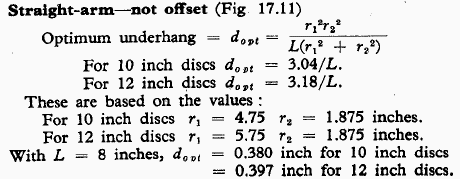
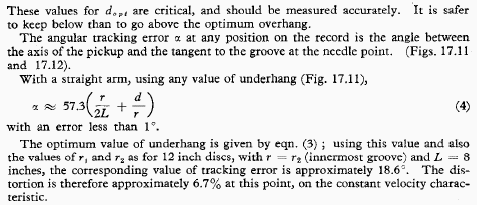
So with this information out in the open, it
should be clear that for the best hi fi reproduction, the offset arm is the
best choice. The Scratch DJ straight arm is not.
The
straight arm has found a new home with Scratch DJ's, because, the needle is
more stable in the groove when the platter is being spun back and forth as that
artform requires. The trade off is excessive groove wear and distortion.
Because of the excessive tracking error of 17 degrees, you
must never use elliptical styli in a Scratch DJ straight arm. The fine edges of the
elliptical profile depend on near perfect tangental alignment. With an error of
17 degrees, these fine edges become sharp cutting tools and will shave the
surface of the vinyl groove. Stick with conical or spherical shaped styli when
using a straight Scratch DJ tonearm.
This presents a
dilemma for the home enthusiast because many of these Scratch DJ turntables are
coming equipped with 78 speed which makes them appealing to record collectors.
Our advice is to choose a conventional offset tonearm style instead. Leave the
straight tonearm for the Scratch DJ's. If you have read this and understand it,
tell a friend and pass the word. It will make life alot easier for the
collector or audio enthusiast about to make a turntable purchase.
A few
final notes:
1. Were discussing Scratch DJ straight pivoted underhung
tonearms, not linear tracking straight tonearms nor straight tonearms with
proper overhang and the offset angle in the headshell.
2. Some turntable
mfg.'s have recommended offsetting the cartridge in the headshell with these
Scratch DJ straight arms. Do not do it! As the article instructs above, keep
everything straight.
You should not introduce an
offset angle into a straight underhung tonearm.

Copyright © 2001 KAB All Rights
Reserved.
KAB ELECTRO ACOUSTICS
P.O.BOX
2922
PLAINFIELD, NJ 07062, USA
PHONE 908-754-1479
FAX
908-222-3442
EMAIL TO INF0@KABUSA.COM





